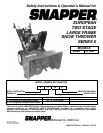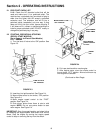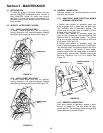
3
IMPORTANT SAFETY INSTRUCTIONS
OPERATIONAL PRECAUTIONS
(Continued From Previous Page)
7. DO NOT put hands or feet near or under rotating
parts. Keep clear of the discharge opening at all
times.
8. Start engine only where exhaust fumes will be safely
dissipated. Allow a brief warm-up period, and
practice operation of controls outside before putting
the machine to work.
9. After striking a foreign object, STOP the engine
(motor), remove the key, and remove the wire from
spark plug. Thoroughly inspect the snow thrower for
any damage, and repair the damage before restarting
and operating the snow thrower.
10. STOP the engine if the machine starts to vibrate
excessively as this normally indicates mechanical
problems. Remove the key and disconnect the spark
plug wire to prevent unintentional starting before
servicing or repairing the machine.
11. DO NOT clear snow across the face of slopes.
Exercise extreme CAUTION when changing direction
on slopes. DO NOT attempt to clear steep slopes.
12. DO NOT leave machine unattended with the engine
running. STOP engine and remove key to prevent
unauthorized operation.
13. Release clutch control and make sure auger/impeller
has STOPPED before adjusting deflector, or placing
hands near auger/impeller.
14. DO NOT use snow thrower on surfaces above
ground level, such as, a roof of a building.
15. Exercise extreme CAUTION when operating on or
crossing gravel drives, walks, or roads. Stay alert for
hidden hazards or traffic.
16. DO NOT overload the machine capacity by
attempting to clear snow at too fast a rate.
17. Never operate the machine at high transport speeds
on slippery surfaces. Look behind and use care
when backing.
18. Disengage power to the auger/impeller when snow
thrower is transported or not in use.
19. Use only attachments and accessories approved by
the manufacturer of the snow thrower (such as
wheels weights, counterweights, cabs and the like).
20. Never operate the snow thrower without good
visibility or light. Always be sure of your footing, and
keep a firm hold on the handles. Walk; never run.
SAFE HANDLING OF GASOLINE
To avoid personal injury or property damage, use
extreme care in handling gasoline. Gasoline is extremely
flammable and the vapors are explosive
1. Extinguish all cigarettes, cigars, pipes and other
sources of ignition.
2. Use only an approved fuel container.
3. DO NOT remove fuel cap or add fuel with the engine
running. Allow the engine to cool before refueling.
4. DO NOT refuel the machine indoors.
5. DO NOT store the machine or fuel container inside
where there is an open flame, spark or pilot light
such as on a water heater or other appliances.
6. DO NOT fill fuel containers inside a vehicle or on a
truck or trailer bed with a plastic liner. Always place
the containers on the ground away from the vehicle
before filling.
7. Remove gas-powered equipment from the vehicle or
trailer and refuel it on the ground. If this is not
possible, then refuel equipment using a portable
container, rather than a gasoline dispenser nozzle.
8. DO NOT start gas powered equipment in enclosed
vehicles or trailers.
9. Keep the nozzle in contact with the rim of the fuel
tank or container opening at all times until fueling is
complete. DO NOT use a nozzle lock-open device
10. If fuel is spilled on clothing, change clothing
immediately.
11. Never overfill a fuel tank. Replace fuel cap and
tighten securely.
MAINTENANCE AND STORAGE
1. DO NOT store machine or fuel container inside
where fumes may reach an open flame, spark, or
pilot light as in a water heater, furnace, clothes dryer
or other gas appliance. Allow engine to cool before
storing machine in an enclosure. Store fuel container
out of reach of children in a well ventilated,
unoccupied building.
2. Keep machine and engine free of excess oil, grease
and spilled fuel to reduce fire hazard.
3. When draining fuel tank, drain fuel into an approved
container outdoors and away from open flame.
4. Inspect all bolts, nuts and screws frequently and
keep properly tightened.
5. Use only recommended shear bolts (if equipped) to
prevent possible damage to machine.
6. Service engine and make adjustments only when
engine is stopped. Remove key, remove wire from
spark plug, secure wire away from plug, and
disconnect cord from electric starting motors to
prevent accidental starting.
7. DO NOT change engine governor speed settings or
overspeed engine.
8. DO NOT test for spark by grounding the spark plug
next to spark plug hole. Spark from the plug could
ignite gas exiting engine.
9. Have machine serviced by an authorized SNAPPER
dealer at least once a year and have the dealer install
any new safety devices.
10. Use only genuine SNAPPER replacement parts to
assure that original standards are maintained.


















